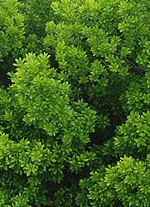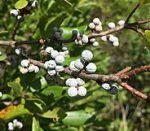 This upright, suckering shrub is a native of coastal North America and was important in colonial times when candles were made from the berries. It is a member of the bayberry family, Myricacae, that also includes wax-myrtle. Deciduous or semi-evergreen, depending on the climate, northern bayberry is irregular to mounded and has one to four inch long dark green aromatic leathery leaves that slowly turn bronze to tan in winter. Male and female flowers are produced on separate plants and one male should be planted for every five females to ensure good fruit set. Small wax covered gray-green berries are produced by female plants in the fall. Northern bayberry fixes its own nitrogen from the air so does well on infertile soil. It is effective for large-scale masses, shrub borders, and informal hedges, and can be used to stabilize soils because of its colonizing nature. It is tolerant of wind and salt so is an excellent plant for seaside plantings. The genus name, Myrica, is derived from the Geek name for tamarisk, myrike. The specific epithet, pensylvanica, is the Latininzed form of Pensylvania and refers to an area where the plant is native.
This upright, suckering shrub is a native of coastal North America and was important in colonial times when candles were made from the berries. It is a member of the bayberry family, Myricacae, that also includes wax-myrtle. Deciduous or semi-evergreen, depending on the climate, northern bayberry is irregular to mounded and has one to four inch long dark green aromatic leathery leaves that slowly turn bronze to tan in winter. Male and female flowers are produced on separate plants and one male should be planted for every five females to ensure good fruit set. Small wax covered gray-green berries are produced by female plants in the fall. Northern bayberry fixes its own nitrogen from the air so does well on infertile soil. It is effective for large-scale masses, shrub borders, and informal hedges, and can be used to stabilize soils because of its colonizing nature. It is tolerant of wind and salt so is an excellent plant for seaside plantings. The genus name, Myrica, is derived from the Geek name for tamarisk, myrike. The specific epithet, pensylvanica, is the Latininzed form of Pensylvania and refers to an area where the plant is native.
Type: Semi-evergreen to deciduous shrub
Outstanding Features: Tolerance of salt and infertile soils; waxy berries
Form: Upright, spreading; irregular to mounded; colonizing
Growth Rate: Medium from old growth, fast from root suckers
 Bloom: Male and female flowers are produced on separate plants in spring; waxy gray-green berries are produced by female plants
Bloom: Male and female flowers are produced on separate plants in spring; waxy gray-green berries are produced by female plants
Size: 1-12′ H x 6-12′ W (typically 5-6 ‘ H; plants in coastal area tend to be low growing.)
Light: Full sun but tolerates some shade
Soil: Infertile, dry, slightly acidic; tolerates wet soil
Hardiness:Zones 2-7
Care:Prune to renew branches; cut old leggy plants to the ground to rejuvenate.
Pests and Diseases:None of significance but susceptible to leaf spots, dieback, stem rots, root rots, rust.
Propagation: Fresh seed; layering; cuttings in summer; divisions of suckering plants.
Photo Credits: Wikipedia
